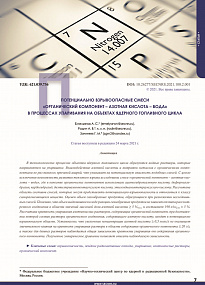Water solutions are formed during the technological processes of nuclear fuel cycle facilities and sent for evaporation. The interaction of nitric acid and nitrates with organic components had repeatedly caused accidents, which indicated the potential danger of such mixtures. In order to exclude the possibility of a thermal explosion, the mixtures “organic component – nitric acid – water” were studied, where acetohydroxamic acid, diformylhydrazine, carbohydrazide, diethylenetriaminepentaacetic acid, and ethylenediaminetetraacetic acid were used as organic components. The content of each constituent in the mixtures suspected to pose a potential explosion hazard and relate to self-reactive substances was calculated. Volume of gaseous products formed during the decomposition of the studied mixtures was estimated. The volume of gaseous products released during the reaction did not depend on the type of the considered compound in the range of values of the nitric acid mass fraction ≥ 5 % by weight and was counted as 190 l/kgsolution ± 5 %. Volume reduction of the nitric acid solutions containing the organic component was calculated, at which such solutions entered a potentially explosive region. It was found that concentration of nitric acid increase ≥ 0,5 mol/l did not significantly affect the volume reduction of the solution in the range of the organic component content ≤ 20 g/l, and for these solutions there occured the volume reduction as a function of the organic component content. The empirical relationship allowed to describe the observed dependence.
Keywords: explosion hazard, liquid radioactive waste, evaporation, nitric acid solutions, organic component.
Article language: Russian. Pp. 7–19. DOI: 10.26277/SECNRS.2021.100.2.001.


